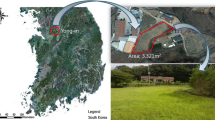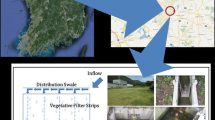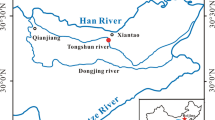Abstract
The efficiency of a facility to remove non-point source pollution is likely to fluctuate according to conditions such as facility type and rainfall events; therefore, it is required to use a proper method to estimate removal efficiency. This study was conducted to estimate the efficiency of a facility with vegetative filter strips to remove pollutants by using methods previously used for the estimation of removal efficiency and compensate for weaknesses of the known methods. Other ways were presented to estimate an efficiency by which rainfall events were classified according to meteorological condition and amount of rainfall. Rainfall of frequency and summation of load as rainfall of frequency, where the frequencies per rainfall class were considered in efficiency ratio and summation of loads, respectively, seemed to have higher removal efficiencies than those estimated with the previous methods. Although it rained at the basin site, often in small quantity (below 10 mm), the rainfall events of below 10 mm were less frequent, during the monitored rainfall events, which accordingly resulted in low removal efficiencies. However, if the frequencies per rainfall class were considered, overall removal efficiencies of VFS might be increased because the removal efficiencies of the rainfall class under 10 mm was higher than other rainfall classes. Therefore, it is desirable to take into account such factors as effects of rainfall when it comes to measuring the removal efficiency of a non-point source pollutant of a factor, because those facilities are likely to be influenced by meteorological conditions including rainfall characteristics.





Similar content being viewed by others
References
American Public Health Association (APHA) (1998) Standard methods for the examination of water and waste water. 20th edn. Washington, DC
Choi JY, Marla CM, Lee SY, Kim LH (2009) Evaluation of a swirl and filtration type BMP using various efficiency determination methods. In: Proceedings 3rd Specialized conference on decentralized water and wastewater international network
Environmental Protection Agency (EPA) (1983) Results of the nationwide urban runoff program, volume I-final report. Water Planning Division, Washington, DC
Environmental Protection Agency (EPA) (2002) Urban Stormwater BMP Performance Monitoring. EPA/821/B-02/001, Washington, DC
Gaga EO, Tuncel G, Tuncel SG (2009) Sources and wet deposition fluxes of polycyclic aromatic hydrocarbon (PAHs) in an urban site 1000 meters high in Central Anatolia (Turkey). Environ Forensics 10:286–298
Guo Y, Wan Z, Liu D (2008) Dynamics of dissolved orgnic carbon in the mires in the Sanjiang Plain, Northest China. J Environ Sci 22(1):84–90
Kim GH (2006) Mortality rates of pathogen indicator microorganisms discharged from point and non-point sources in urban area. J Korean Soc Water Qual 22(6):1075–1081 (in Korean)
Kim LH, Lee SH (2005) Characteristics of metal pollutants and dynamic EMCs in a parking lot and a bridge during storms. J Korean Soc Water Qual 21(4):385–392 (in Korean)
Lee BS, Gil KI (2008) Effect of plant coverage on the treatment efficiency of nitrogen and phosphorus in vegetative filter strips. J Korean Soc Water Qual 24(4):499–503 (in Korean)
Lee SY, Lee EJ, Kim CM, Son HG, Marla CM, Son YK, Kang HM, Kim JH, Kim LH (2007) Characteristics of wash-off metal pollutants from highway toll-gate area. J Korean Soc Water Qual 23(6):945–950 (in Korean)
Lee SB, Yoon CG, Jung KW, Jang JH, Jeon JH (2008) Analysis of relationship between spatial distribution of land use and water quality in agricultural reservoirs. Korean J Limmol 40(3):481–488 (in Korean)
Lee EJ, Seong CH, Kim HK, Park SW, Kang MS (2010) Predicting the impacts of climate change on nonpoint source pollutant loads from agricultural small watershed using artificial neural network. J Environ Sci 22(6):840–845 (in Korean)
Liu C, Wu G, Mu H, Yuan Z, Tang L, Lin X (2008) Synthesis and application of lignin-based copolymer LSAA on controlling non-point source pollution resulted from surface runoff. J Environ Sci 20(7):820–826
Maciej D (2000) Activities in non-point pollution control in rural areas of Poland. Ecol Eng 14:429–434
Martin EH, Smmot JL (1986) Constituent-load changes in urban storm water runoff routed through a detention pondwetland system in central Florida. Water Resources Investigation Report 85–4310. U.S. Geological Survey, Florida
Miller GT (1992) Living in the environment: an introduction to environmental sciences, 7th edn. Brooks/Cole, Belmont, pp 602–611
Ministry of Environment (MOE) (2008) Design and maintenance guidelines of the stormwater BMPs (in Korean)
Seo JY, Shin MH, Won CH, Choi YH, Jung MS, Lim KJ, Choi JD (2010) Characteristics of NPS pollution from coal mining. J Korean Soc Water Qual 26(3):474–481 (in Korean)
Shouakar-Stash O, Frape SK, Aravena R, Gargini A, Pasini M, Drimmie RJ (2009) Analysis of compound-specific chlorine stable isotopes of vinyl chloride by continuous flow-isotope ratio mass spectrometry (FC-IRMS). Environ Forensics 10:299–306
Wang X, Hao F, Cheng H, Yang S, Zhang X, Bu Q (2011) Estimating non-point source pollutant loads for the large-scale basin of the Yangtze River in China. Environ Earth Sci 63:1079–1092
Wee SK, Kim LH, Jung YJ, Gil KI (2008) Washoff characteristics and correlation of nonpoint pollutants in a bridge storm runoff. J Korean Soc Water Qual 24(3):378–382 (in Korean)
Wu L, Yu T, Cooper WJ (2012) Simulation of spatial and temporal distribution on dissolved non-point source nitrogen and phosphorus load in Jialing River Watershed, China. Environ Earth Sci 65:1795–1806
Zhang M, Chen H, Wang J, Pan G (2010) Rainwater utilization and storm pollution control based on urban runoff characterization. J Environ Sci 22(1):40–46
Author information
Authors and Affiliations
Corresponding author
Rights and permissions
About this article
Cite this article
Shin, J., Gil, K. Effect of rainfall characteristics on removal efficiency evaluation in vegetative filter strips. Environ Earth Sci 72, 601–607 (2014). https://doi.org/10.1007/s12665-013-2995-6
Received:
Accepted:
Published:
Issue Date:
DOI: https://doi.org/10.1007/s12665-013-2995-6




